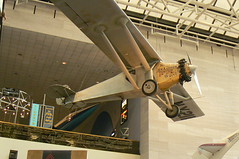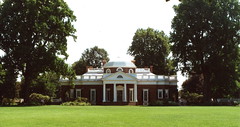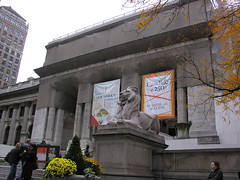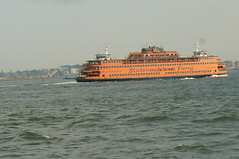Travel to Biosphere 2: Science’s version of Big Brother
Tuesday, December 22nd, 2009In September, 1991 until September, 1993, eight people lived together in one very large “house,” Biosphere 2. (more…)
In September, 1991 until September, 1993, eight people lived together in one very large “house,” Biosphere 2. (more…)
More than once I have been talking to someone from outside Arizona who says, “I have relatives who live in Tucson.” It’s interesting that no one ever says, “I have relatives who live in Phoenix.” I know it’s just an odd coincidence, but it’s still interesting.
So, what is it about Tucson that attracts a slew of wealthy retirees and others to make it their home? (more…)
By Guest Author Peggy Bradshaw; Photos by George Bradshaw
The Smithsonian National Air and Space Museum (NASM) maintains the largest collection of historic air and spacecraft in the world. Located in Washington, DC on the National Mall, it also has a companion facility at the Steven F. Udvar-Hazy Center near Washington Dulles Airport at Chantilly, VA.
The space shuttle Enterprise is housed at the Udvar-Hazy Center, as is one of Amelia Earhart’s planes.
The NASM holds in trust some 50,000 objects, including air craft, space craft, engines, rockets, uniforms, space suits, balloons and artwork. The Wright Brothers 1903 Flyer is on display with related artifacts. A whole section is dedicated to the Wright Brothers with original and replica flying machines.

Charles Lindbergh's Spirit of St. Louis
Okay, you’ve got some money, you’ve got some land up on a hill, and you’ve got some brains. But, what you don’t have is a place to live! What will you do? What will you do?
Thomas Jefferson, never at loss to come up with a new idea, decided he was going to build a house on the hill as the centerpiece to his 5,000-acre plantation.
And talk about privacy! You can’t see it from the road, even if you know where to look.
Preparation of the site began in 1768 with construction beginning the following year. With approximately 11,000 sq. ft. of living space, this is not your basic suburban master-planned community house. Monticello was designed by Jefferson after a visit to Europe. The Roman neoclassic design contains forty-three rooms following a remodeling expansion completed in 1809.
Much of the construction material came from the land around the house. The window glass came from Europe and about one-third of the glass now in the house is original.

Monticello - Thomas Jefferson's home
Of interest is Jefferson’s bed, which he designed after seeing alcove beds during his time in France. Taking the idea of beds built into walls upon his return from Europe, Jefferson redesigned Monticello, adding an alcove bed to his bedroom, but leaving both sides open. This connected his bedroom with his study. So, Jefferson was never totally hidden away in his bedroom, but was able to access both rooms easily. Obviously, Jefferson was not a man to rest easily.
Tours of the house run constantly throughout the day with timed tickets, so it is best to visit other areas of Monticello following your background tour.
Those background tour areas include the Gardens, dependencies, Mulberry Row and Jefferson’s gravesite.
Tickets are available throughout the day on a first come-first served basis. Tours of the house begin every 10 minutes.
House Tour/Grounds: Nov. – Feb. $15.00 / March – October $20.00
Age 6-11: $8.00
Hours Vary – See Website for calendar of hours.
Tomorrow – Come back for a retrospect on our blog and some things to be thankful for.
A greatly expanded visitor’s center is now located at the former Tredegar Iron Works overlooking the James River. The former foundry pushed out cannons and high quality munitions for the Confederacy during the Civil War along with steam locomotives. Fortunately the building survived the burning of Richmond in April 1865 as Confederate troops were ordered to destroy munitions plants as they evacuated the city.
Rumor has it that the owner of the building “hired” armed guards to keep the arsonists away. Thus, Tredegar is one of only a few buildings that survived the burning of Richmond. (more…)
By Guest Author Peggy Bradshaw; Photos by George Bradshaw
Commonly called just “Virginia Tech,” the Virginia Polytechnic Institute and State University is located on 2,600 acres in Blacksburg, VA and contains 125 buildings. It was founded in 1872 as a public grant college and has worked its way up to be one of the top public universities in the United States.

Virginia Tech "Hokie" stone building
If you think the Civil War ended nearly 150 years ago, you’ve never been to Richmond, Virginia. It’s a place where people still have the last name of Lee and are most likely direct descendents of the famous General who almost, or at least could have, worked for the “other side.”
Although Robert E. Lee was not born in Richmond (actually at his family home of Stratford Hall near Lerty, Virginia), nor is he even buried there (that would be in a chapel at Washington & Lee University in Lexington, Virginia), his legacy lives on if not more than in a large statue on Monument Avenue. (more…)
It’s the Capitol of Virginia, but it has also been the Capitol of the Confederacy, a claim no other U.S Capitol can come close to. Although the Civil War has been over for 144 years, the past lives on alongside the present.
As a former resident of the city for several years, it’s always interesting to come back and re-visit just why you lived somewhere, and maybe even why you left. In the case of Richmond, I relocated there for a job and left for the same reason.
Richmond is a mix of a modern and also a “stuck in the past” city. The latter would be their Civil War heritage.
But, that shouldn’t stop anyone from visiting as there are many things to see and do and you don’t have to see a single battlefield, Civil War or Revolutionary War, if you don’t want to, and still have a great time.
Are you into literature? Edgar Allen Poe lived in Richmond for over 13 years. The Poe Museum is located on Broad Street (Poe didn’t actually live in the house, but nearby). Furniture from his home, as well as manuscripts, first editions and personal belongings, are on display.
Architecture? How about a 15th century English estate (Agecroft Hall) that was bought at auction, crated and shipped from Lancashire, England to Richmond, and reassembled on the banks of the James River.
Famous speeches? Revolutionary leader Patrick Henry wasn’t shy about speaking. He gave his famous “stick it to King George” speech, “Give Me Liberty, or Give Me Death” at St. John’s Church in Richmond.
www.historicstjohnschurch.org/hist_main.htm
Monuments? How about … Monument Avenue? Northwest of downtown Richmond you’ll find Robert E. Lee on a horse … J.E.B. Stuart, on a horse … Stonewall Jackson, on a horse … Jefferson Davis (President of the Confederate States of America), not on a horse.
Anyone notice a theme … and we’re not talking about the horses.
And then, there is Matthew Fontaine Maury. Who? Seriously, WHO?
And finally, a slightly controversial choice for an avenue with statues of Confederate soldiers — we have
Arthur Ashe, professional tennis player, born and raised in Richmond.
Even if you don’t like statues, the architecture along the avenue ranges from English Tudor, Georgian, Italian, and Art Deco on either side of center islands of huge trees and green grass. It’s the kind of street they don’t build anymore.
Historic Theatres with a Pipe Organ? The Byrd Theatre in Carytown, a retail shopping area northwest of downtown was opened in 1928. Included in its 1,300 seat configuration is a balcony and a Wurlitzer Pipe Organ that opens the show on Saturday evenings by rising from the basement to the stage in front of the screen.
You can’t buy tickets ahead of time, they don’t show previews, and the movies aren’t first run … but at $1.99, I’m not going to complain!
http://www.visitrichmondva.com/
NEXT TIME: We’ll take a trip back in time and look at the Civil War history of Richmond and what remains today.
On my recent trip to New York, I had only four hours to spend before it was time to catch my plane back to Phoenix.
Since I hadn’t been to visit in several years, I pondered the best use of my time. Should I head to a museum? Stroll through Central Park? Shop? Visit a landmark?
The only thing time wouldn’t permit would be a Broadway show – sigh!
So, given my four hours, I decided to reacquaint myself with NYC by just walking around. I did not head to a museum or to Central Park, but chose to travel a multi-block path that had some major highlights to see. It was an overcast day, so the brilliant blue skies I was hoping to see just weren’t there. But Manhattan is still impressive, no matter what the weather.

Macy's - The largest store in the world
Coming up from Penn Station, one of the first sights was Macy’s, “the largest store in the world.” I didn’t go in, because I might never stop myself in time to catch my train to JFK.
Instead, I headed over to…
A major landmark for photographers is B & H Camera. Located on 9th Avenue between 33 & 34th Streets, B & H is THE place for cameras and photography equipment. They’ve got it down to a science and have probably every imaginable piece of photo equipment. The most wonderful part of the store is the knowledgeable staff because they really know their stuff.
Want a flash attachment for a camera? I showed them what I have and they gave me three options! The prices were right and I could leave with my choice, at a good price.
And, no, this is not a paid endorsement for B & H, but it was my second visit.
They’re impressive and also very security conscious. Be prepared to leave large bags at the entrance to claim when you’re ready to leave.
Saddled down with a suitcase, my next stop was Schwartz’s Travel Service where I could leave my suitcase. (Located at 357 W. 36th Street near 9th Ave.) Taking the small elevator to the second floor, I paid $10 to leave my suitcase for the day. Ultimately, I left it for less than two hours, but it gave me the freedom to move quickly.

New York Public Library
Next, I headed over to 5th Avenue to see the sights: The New York Public Library with its lions guarding the entrance (stone, not live), and both the Empire State Building and Chrysler Building in the distance. I considered a trip up to the top of the Empire State Building (now the tallest building in NYC since the devastation of 9/11/01), but that would have required several hours.

Empire State Building - the tallest building in NYC

Chrysler Building
I wandered into a street fair on Avenue of the Americas (6th Avenue) that stretched from about 34th Street to 42nd Street. Traffic was closed down for the entire length of the fair with people sampling food and buying the vendor’s wares. There were a lot of people selling jewelry, scarves, and NY T-shirts. The aroma of the food finally made me break down and try an arepa.
An arepa is a corn cake sandwich fried with mozzarella cheese melted between the two corn cakes. I chose a poor representation because, while it tasted good, it was very thin. As I marched and munched along, I was seeing the profusion of people and remembering the energy of NYC that I have missed.

Carousel in Bryant Park
Strolling through Bryant Park behind the giant New York Public Library, I viewed the glorious, recently refurbished carousel, a permanent fixture for anyone young or young at heart. The NY Public Library is getting a facelift on the outside with the back face totally clean and gorgeous, but the front has coverings to protect passersby from the cleaning. It is an impressive building and many people stop for a photo op near the lions guarding the entrance.

Street scene in Manhattan
That’s one of the best things about New York City and, especially Manhattan; there is so much energy! The colorful signs, places to see, food choices from street vendors to fine dining, and excitement, can’t be topped anywhere.
I know, some might contest that last statement, but I never run out of enthusiasm for NYC and the many opportunities to enjoy. Times Square, entrance to the joys of Broadway, is one of my favorite places in the universe, but this time, the schedule just wouldn’t work.
Colorful, thought provoking and dynamic with events and experiences, New York City is the place where I’d spend a week if I could be in any city in the world. But I only had four hours, so I enjoyed what I could and share it here.
If you decide to go to NYC, get a guidebook like DK or Frommer’s to give you the many choices that you’ll have. And, there are many.
I Love NY
http://www.iloveny.com/home.aspx
B & H Camera
http://www.bhphotovideo.com/
By Guess Author Peggy Bradshaw; Photography by George Bradshaw
Since my paternal grandfather immigrated through Ellis Island in 1902, I was really looking forward to going there. It seemed like something pretty magical that I could walk where he had walked more than a hundred years ago. I think I half expected to see his ghost walking through the building.
A small ferry, jam packed with people, delivered us to the dock, and as the throng of people disembarked and walked forward, I wondered if this was what it was like when he got off the ship from Germany.

Staten Island Ferry to Ellis Island